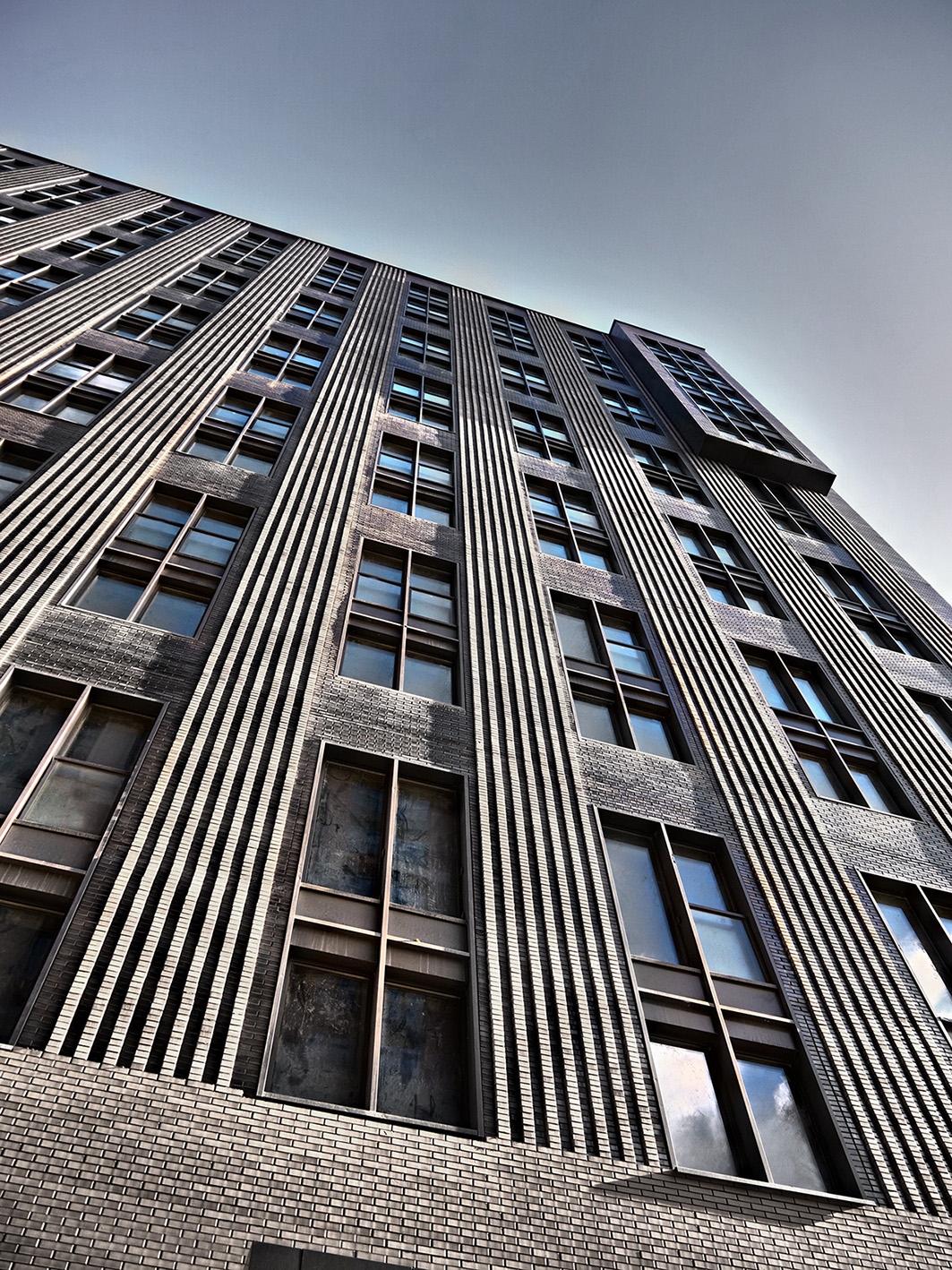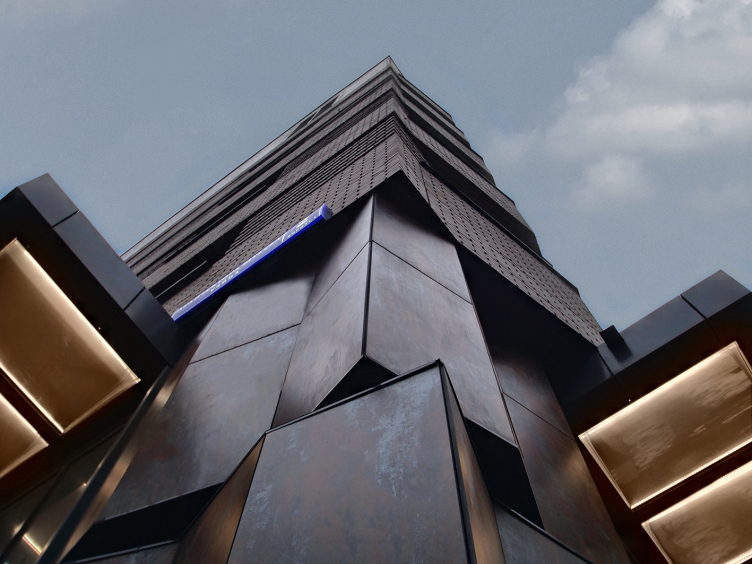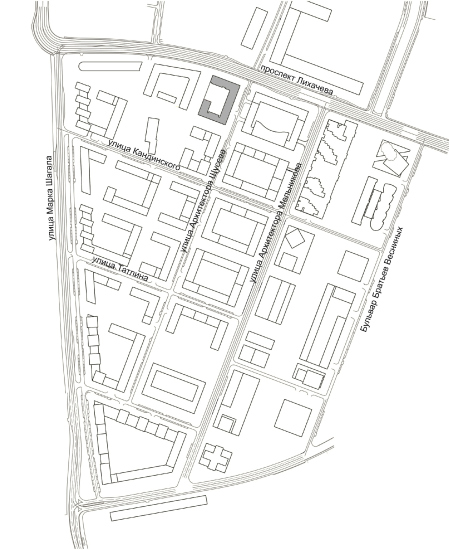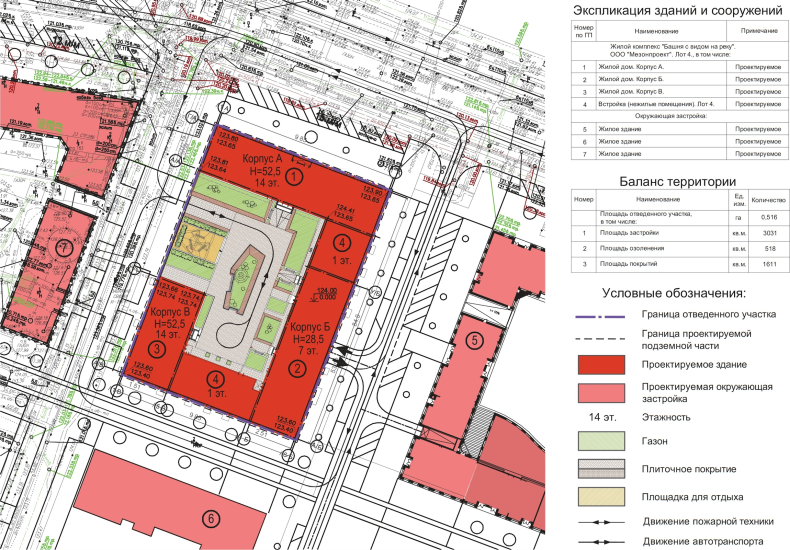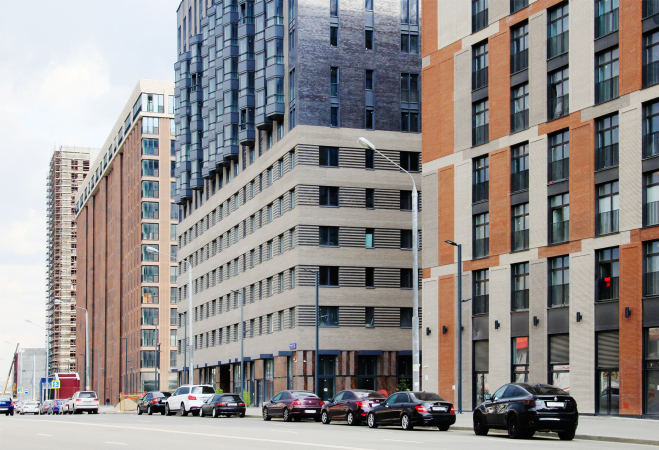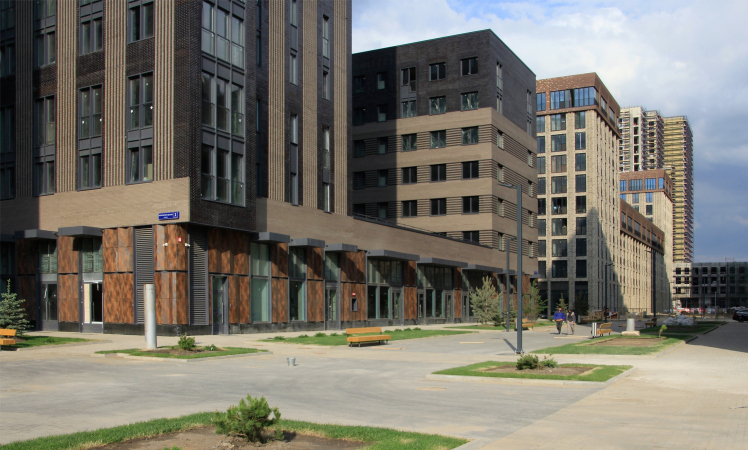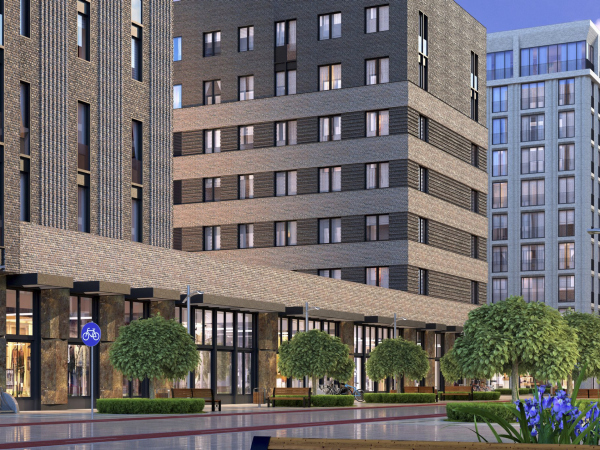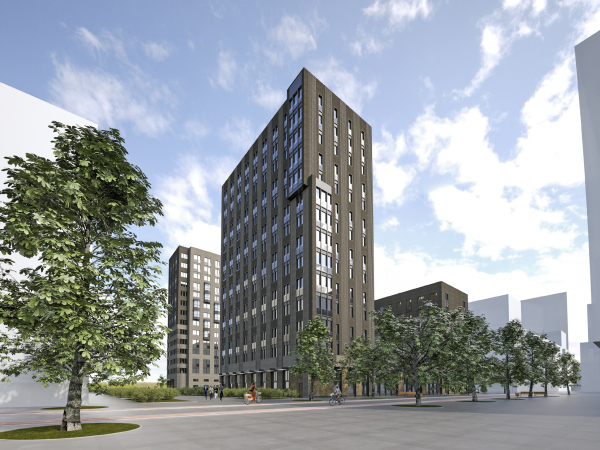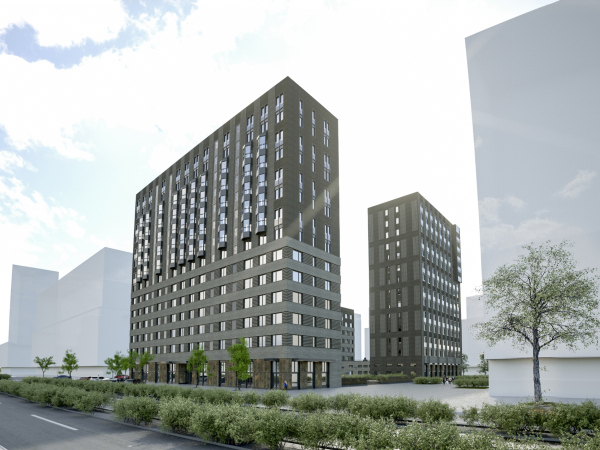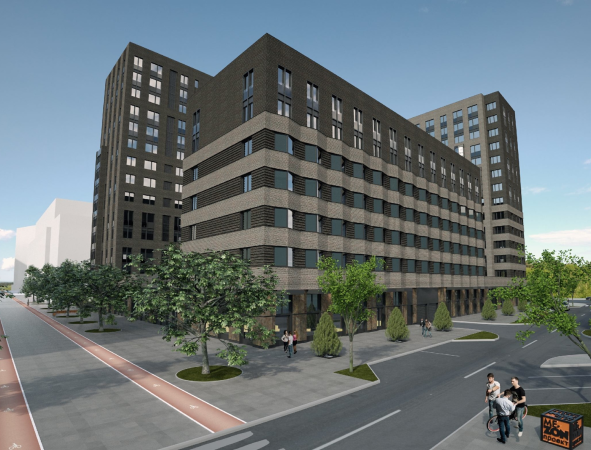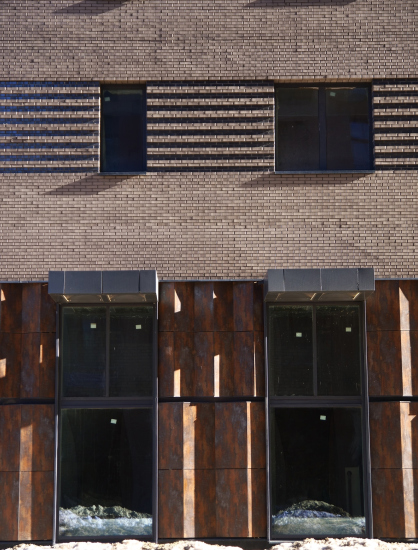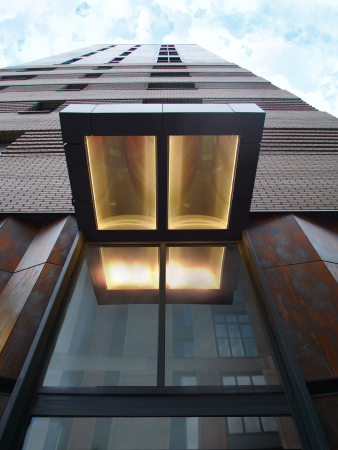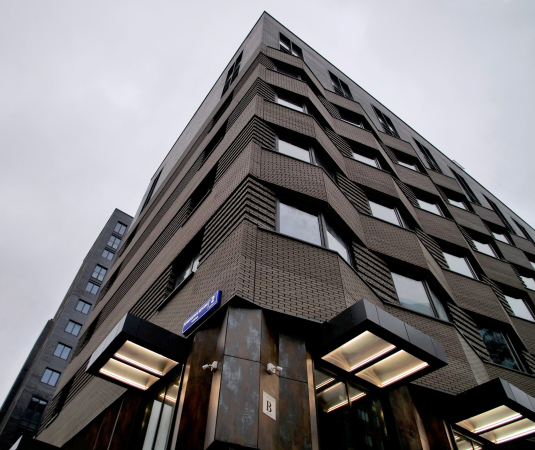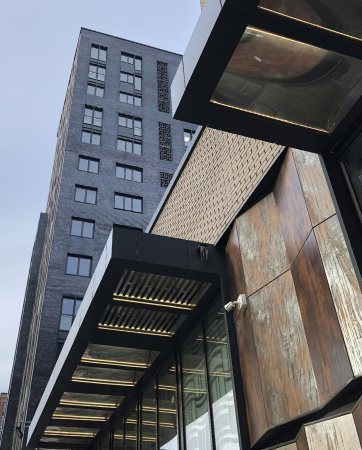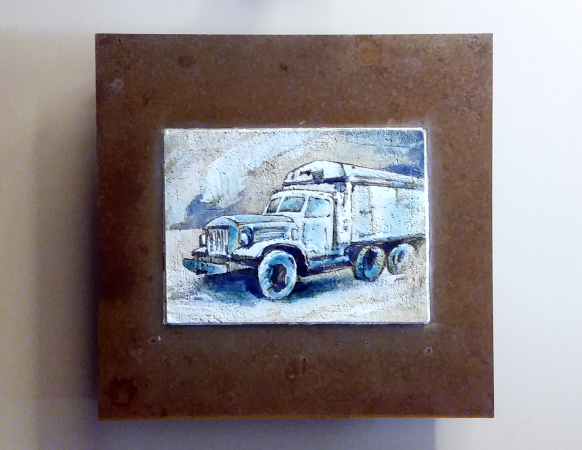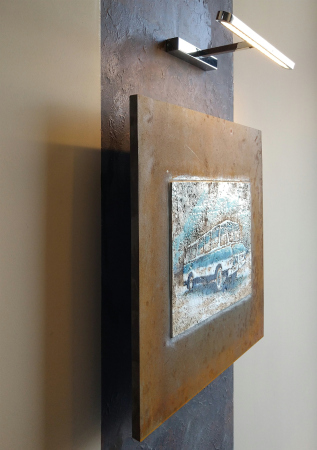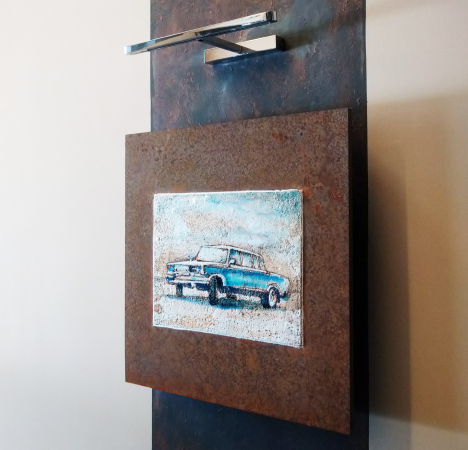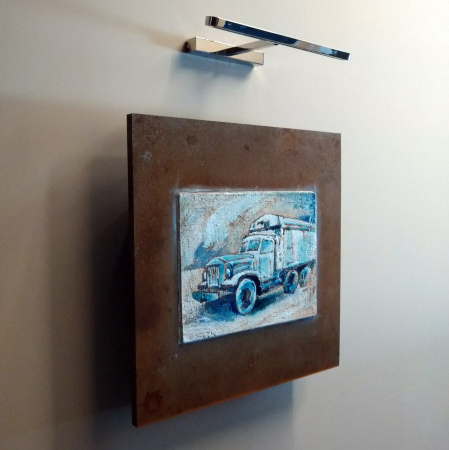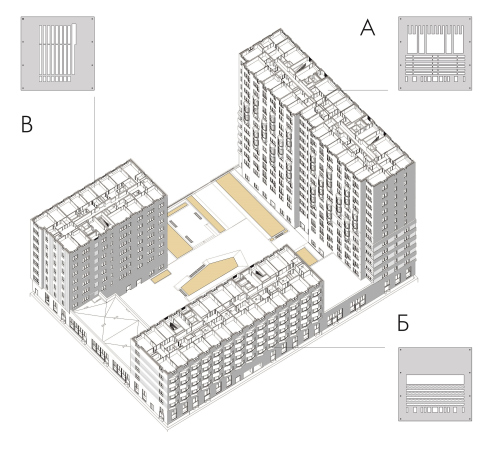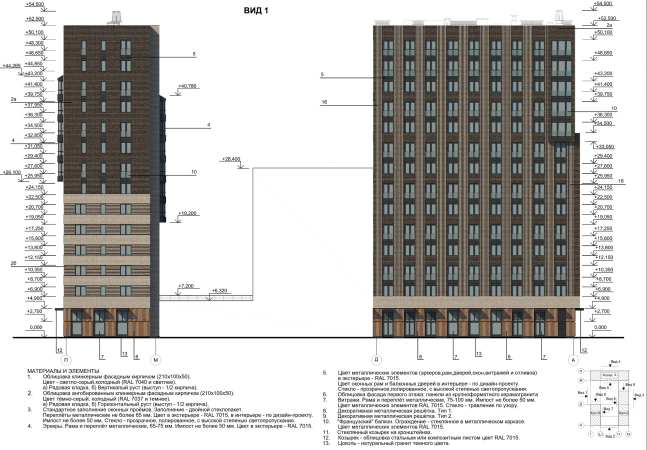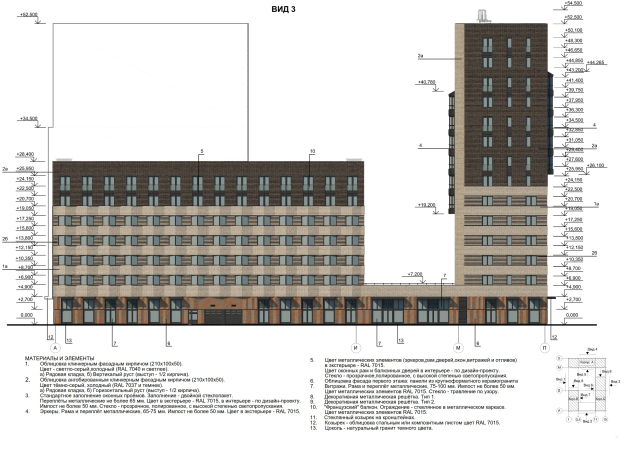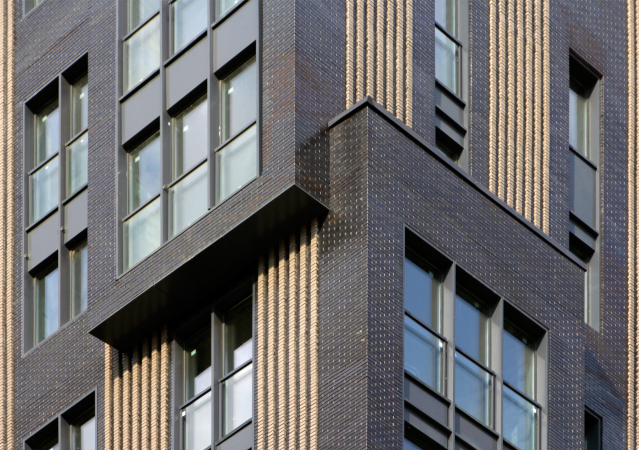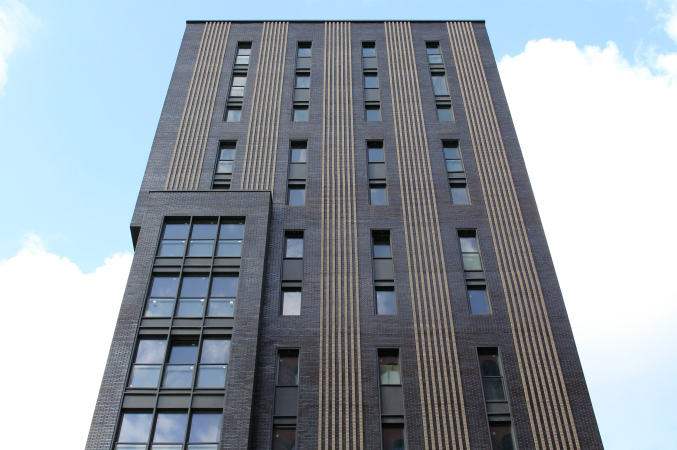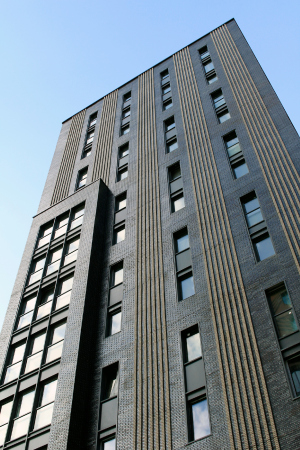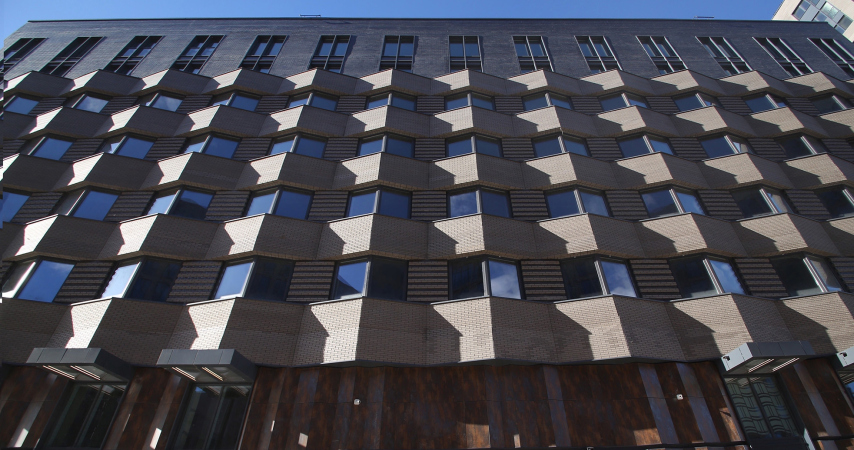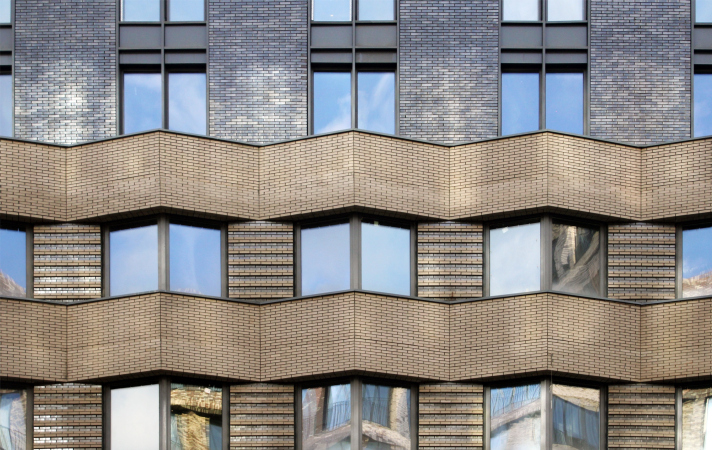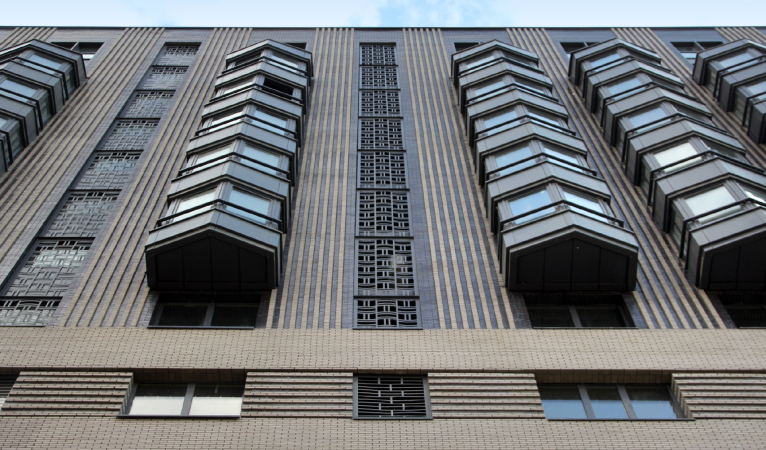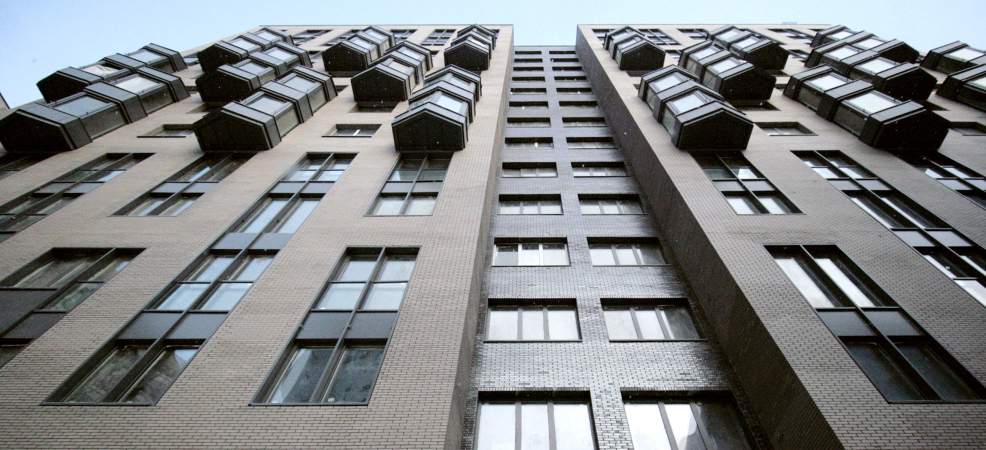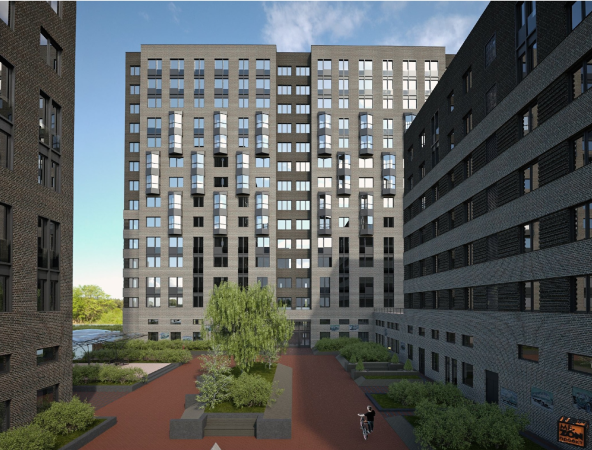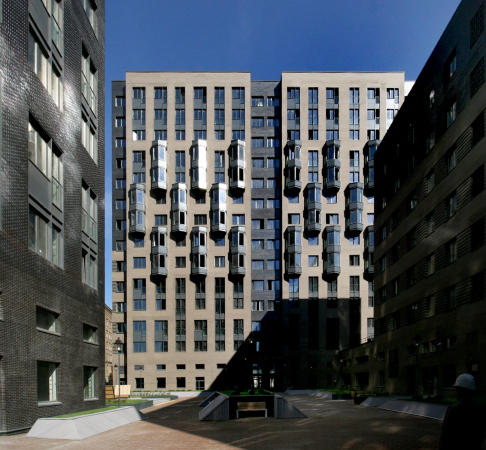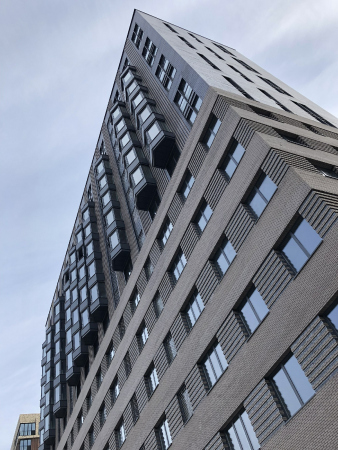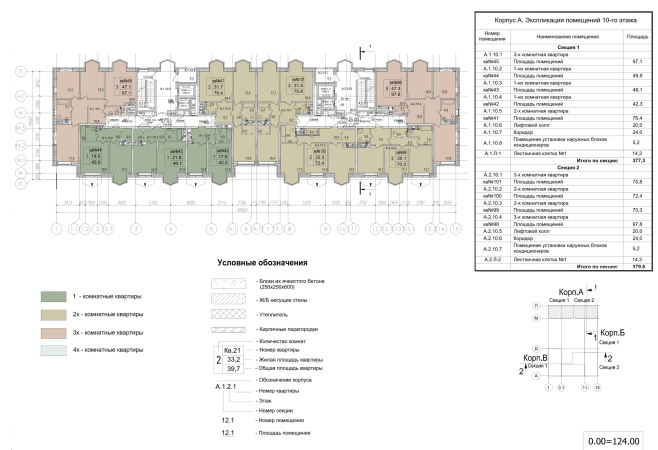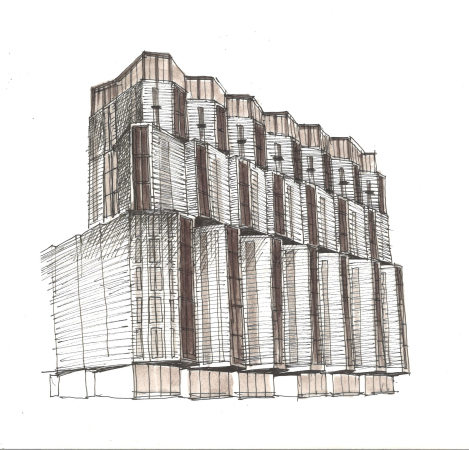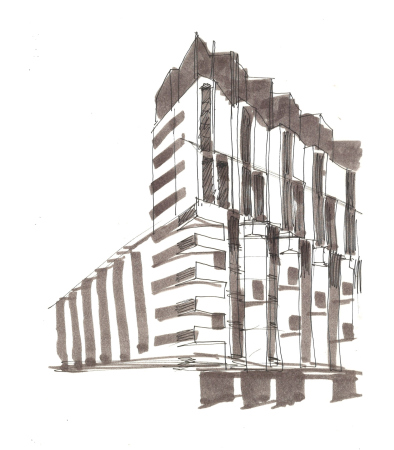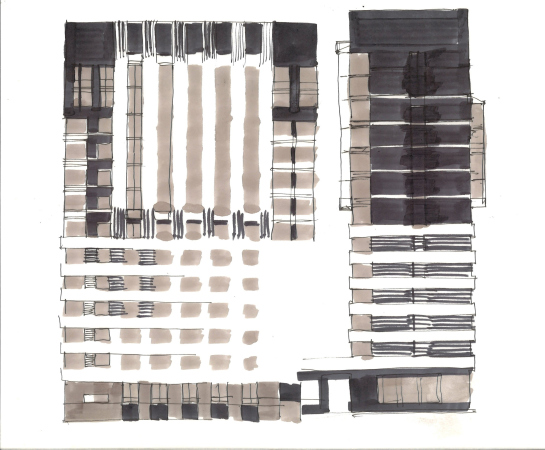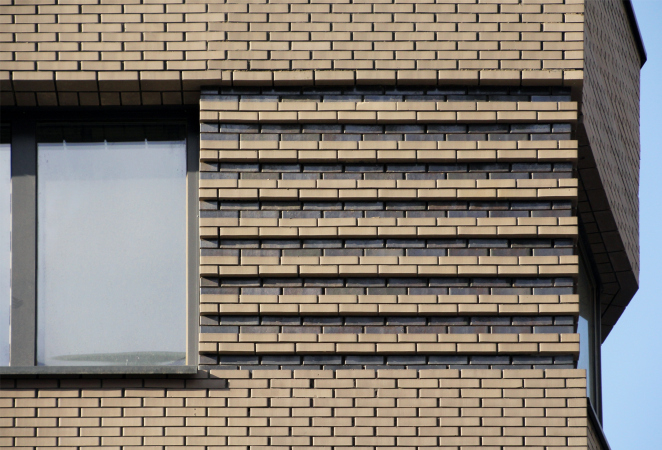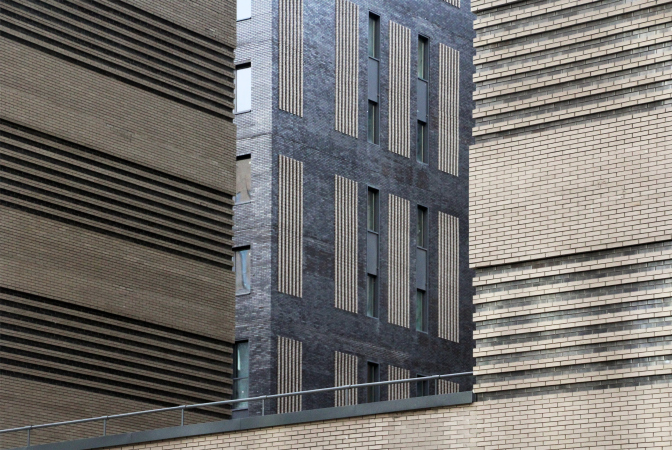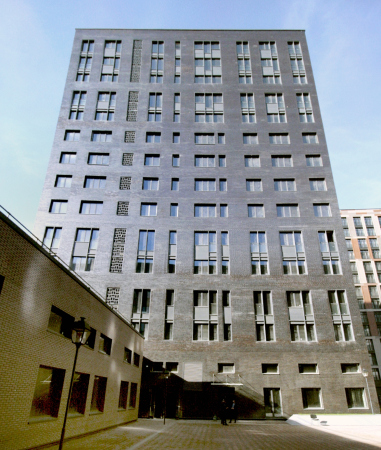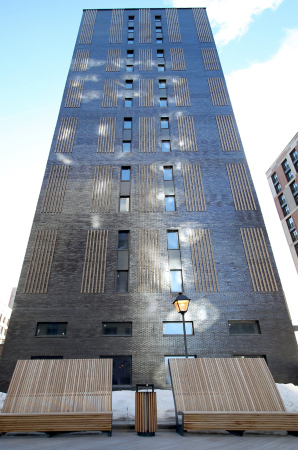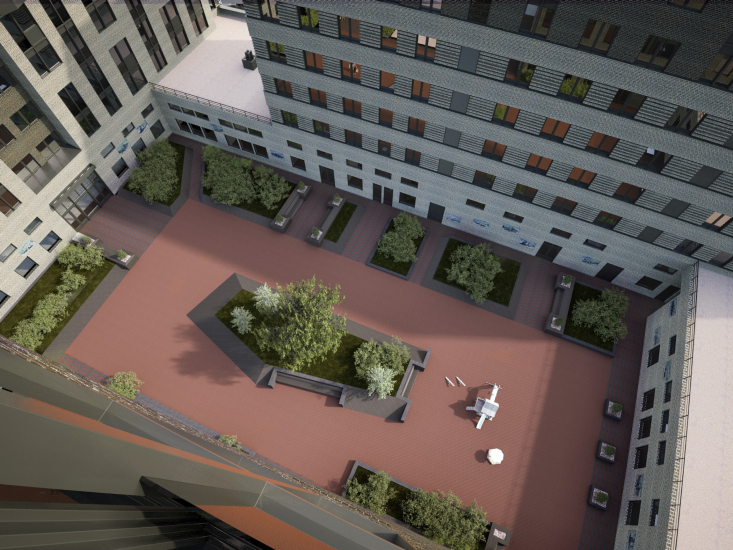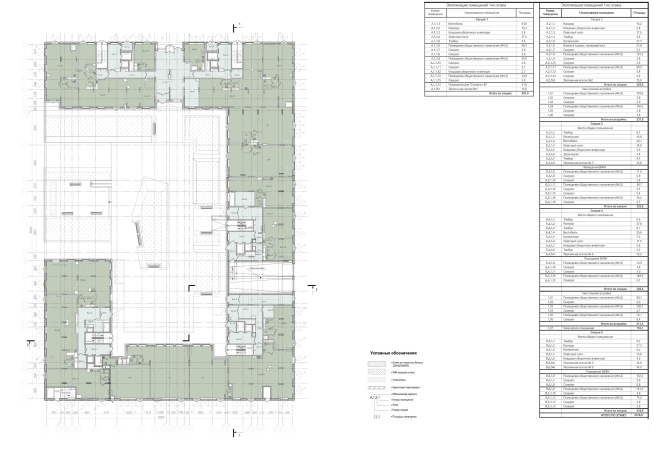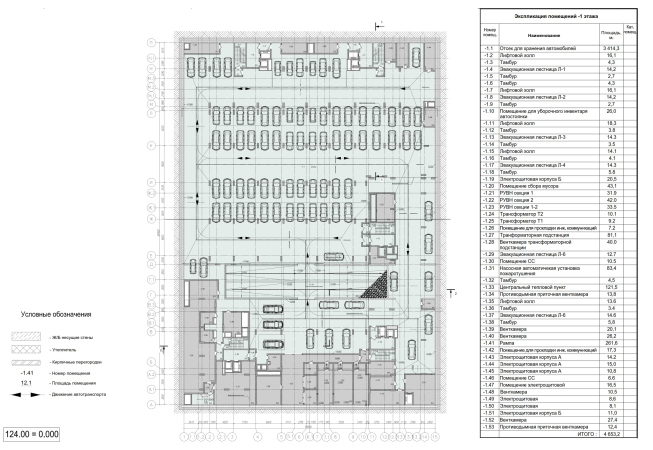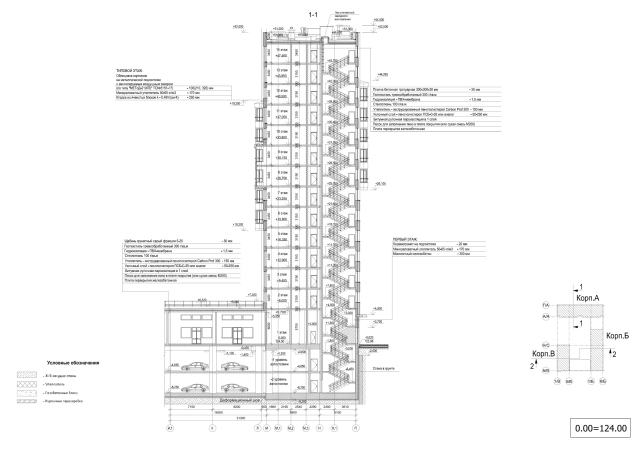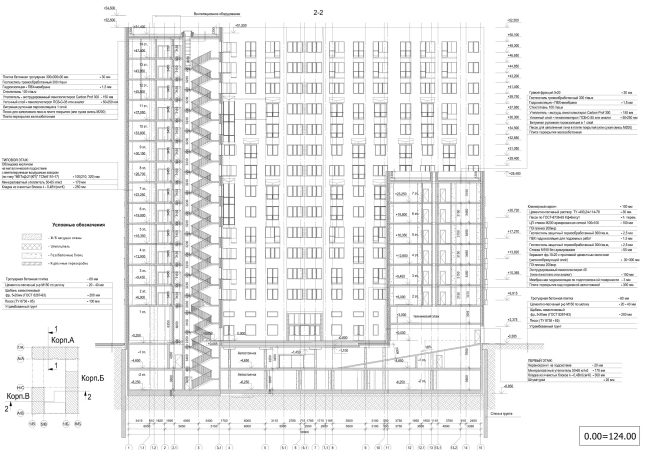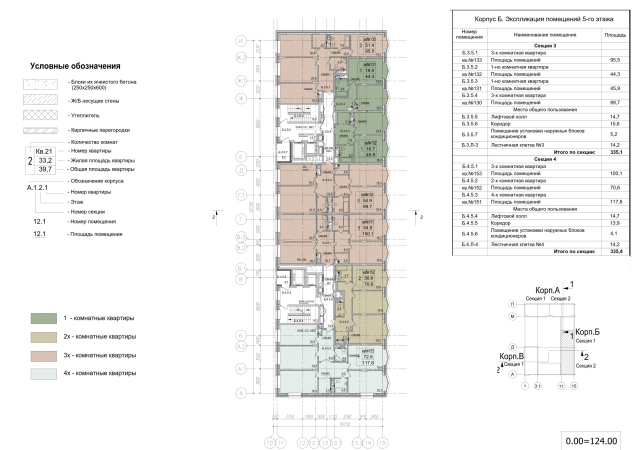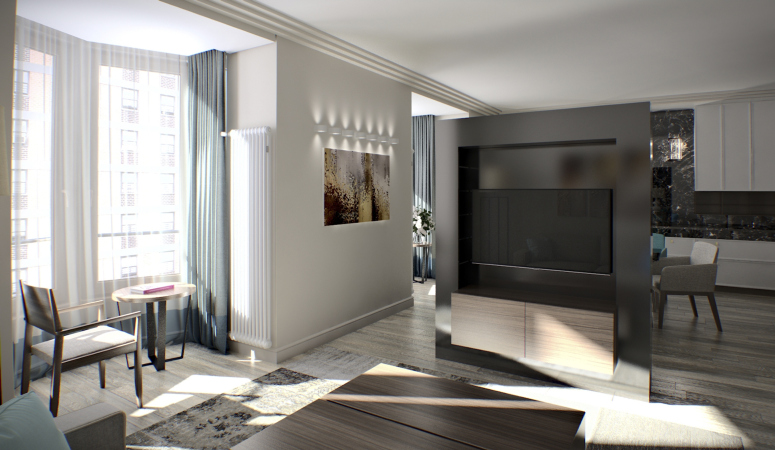Lot №4 is a part of the first stage of ZILART, the grand-scale housing project of LSR company curated by Yuri Grigoryan, who, as is known, defined the master plan as well as the design code of the construction on this formerly automotive peninsula. The design of the first stage of each of the city blocks was commissioned to one reputed architectural company. The lot of “Mezonproekt” is situated on the north border of the complex that coincides with the Likhachev Avenue. Counting from the Moskva River, it is the third behind the buildings designed by Sergey Skuratov and Evgeniy Gerasimov, lying before the city block designed by Sergey Tchoban. Diagonally, its neighbors are the lots designed by Urbis and Meganom. The nearest neighbor from the inner south side is the building designed by “Tsimailo, Lyashenko and Partners”: the architects of Mezonproekt frequently met with its authors discussing the insolation, the color, and the height of the buildings. As a result, an interesting volumetric dialogue appeared: the low-rise houses are placed alongside each other, mutually complementing each other and forming the low-rise construction front along the Shchuseva Street, while the 14-story towers of the two lots are echoing one another.
ZILART housing complex (Lot #4)
Copyright: © Mezonproekt
Yet another specification was the design code that regulated the city block planning, the number of floors, the height of the first floors and their public function. The code also defines the façade coating materials: 70 percent brick, 40 percent other materials and colors: red, white, and shades of gray: dark-colored window transoms. As for the brick, LSR group manufactures it at its own production facility; for ZILART it’s always designer brick, custom-produced by the sketches and requirements from the architects, for the unique texture of each of the lots.
Mezonproekt proposed a solution that was laconic to the point of brutal. The architects selected two kinds of bricks: one dark engobed brick with a glittering surface that reflects the sky, changing color from black-brown to bluish. The other was neutral gray, rugged and looking like sandstone. Together they create a grisailles effect of a sepia hue, like an old faded photograph or an old newsreel. The tone is neutral, even dark.
The third material will be ceramic granite: panels with a surface that looks like Corten steel, like old factory metal. This is the first analogy with ZIL. On the outside, all of the piers of the tall 6-meter high first floor consist of two “bellows” of such rusty-looking material: the bottom one slightly higher, the top one slightly shorter. The zigzagged line is deliberately broken to create an impression that the building is being supported by two belts of some kind of mechanism. At the corners, the intersections become more prominent, and the impression of an old apparatus that once came to a grinding halt but now woke up to support the weight of the house, is strengthened even more.
The “factory” allusions are supported by overnangs: their broad and short blocks with a concave surface backlit at nights look like hot metal molds.
In spite of its certain brutality, this theme is akin to window shop design, which requires either neutrality or some bold statement. Let us note that it is resonant with the modern context of ZILART: Corten steel covers the bottom floors and the “tail” of the comet house #1; a Corten zigzag is also to be seen in the inner building of Lot 2. Lot#4 continues the “factory” theme set by the architect’s colleague, Sergey Skuratov.
The third part of reminiscences about ZIL is to be found inside, and it has a totally graphic character; ceramic panels that display truck vividly remind not only about the factory, but also about Stalin metro stations or the postwar VDNKh exhibition.
Let’s get back outside, however, and raise our gaze. Using two shades of color, the architects act a play dedicated to interrelation between the vertical and horizontal, two main antagonist themes of the architecture of the XX century. The horizontal is to some extent known as the manifesto of avant-garde architecture, like a steam engine tearing down the track, a symbol of ultimate freedom. At the same time, the horizontal is also a characteristic feature of a metallurgical shop, a rolling mill or an assembly line – it’s just not practical to place such things into any kind of tower. The vertical, on the other hand, is a technique that belongs with Art Deco, the antagonists of avant-garde. In the XX century, this became a standard practice: once modernism prevails, the buildings become elongated, their windows turning into “ribbon” ones or at least rectangular, lying on the long side. Once they get tired of modernism, the vertical growth of the towers is supported by pillars, the windows stringing up like a guitar string.
And, while in the XX century the vertical and the horizontal are waging trench warfare, alternately prevailing, today their struggle is more and more often becomes the subject for reflection. So the architects of Mezonproekt gave a chance to speak to both of them. Their scheme explains it all: one 14-story tower, at the corner of the Golosova and Kandinskogo Streets (sic, the names of the ZILART streets will not let us forget about the art of the XX century) – asserts the vertical. The seven-story building on the Shchusev Street cultivates the horizontal, just as the two single-tier buildings that close the contour left and right of it. The house on the Likhachev Avenue combines both themes, the seven bottom floors being subjugated to the horizontal, and the higher floors being vertical.
The vertical tower vividly reminds us about the 1930’s, and about of the State Duma building, as well as about many American (particularly Chicago) examples. A characteristic detail – windows grouped in vertical pairs and divided by a thin metallic lintel – leave no doubt that what we are seeing is Chicago. We are brought back to contemporary by a bay window that asymmetrically embraces the corner – two thirds at the bottom, one third at the top – unobtrusively reminding the observers about the number of the current century so as stop us from being carried away by allusions.
In the horizontal building, the stripes of the flutes make a 90-degree turn and connect the windows with their strokes, highlighting the “ribbon” direction. This Is a technique that can be traced back to the 1960’s-1980’s just as the zigzag of the stripes between the floors. The façade at once becomes volumetric and sculptural; it gets a clear rhythm and a prominent resemblance with the modernist interpretation of the horizontal. Upwards grow two dark flattened floors similar to the neighboring vertical tower – they can be interpreted as a buildup or as the nucleus of the house, surrounded by a large belt of light-colored brick.
Thus, two essentially opposite techniques, belonging one to Art Deco and one to modernism, are brought to one common denominator: a simple relief technique of the “strings” of the stripes. It looks as though the architects were deliberately showing that the heated discussion of the XX century was essentially the fight of Swift’s Lilliput and Blefuscu. And, if we are to reach a high level of generalization, we will be able to add and subtract them, like in a mathematical formula.
And addition is exactly what takes place in the third building: at the bottom, the grooves are horizontal, and they belt the building; higher up, after the seventh floor, they are vertical, like two strokes of the plus sign. The entire façade is subjugated to their rigorous framework. In the upper part the vertical is supported by glass-and-metal “capsules” of the bay windows that look like elevators – it seems, especially if one is looking from below, that they are frozen in mid-motion, and are about to slide up or down. An interesting way to solve the problem of the bay windows looking like a giant thermometer (a common problem for high-rise buildings) was to turn them into a part of the building’s narrative. The bay windows also become an addition to the floor space of the apartments: they stand out pretty far, about two meters from the surface of the inside wall, adding some variety and serving as “skylights” thanks to the triangular shape of their ledges.
It must be noted that the building that overlooks the Likhachev Avenue had a lot more plastique about in the original sketches, and was essentially a stack of “bellow” ribbons composed from asymmetric triangular bay windows. So, very much in a steampunk fashion, the entire house looks like a sculpture of some frozen mechanism, a giant truck. Actually, the zigzag that belts the 7-story building and the triangular bay windows are echoes of that shape, its remnants remaining after its considerable “purge” and “pacifying” by parallel and perpendicular lines.
And now the lines of the main narratives of verticals and horizontals get ornamental additions here and there: sometimes these are strokes on a side wall of the tower, sometimes these are ornamental grilles of the ventilation systems (vertical and horizontal waves alternate in them) – this ornament became the symbol of the building; it is repeated above the entrances as well.
The landscaped yard with laconic chamfers in a frame of flowerbeds and ostentatiously tall backs of the wooden benches is only open in one place, from the side of the Golosova Street. Here it closed by a lattice gate and a door. According to the master plan, the Golosova and Kandinskogo streets, which surround Lot #4 from all sides – are pedestrian promenades, only accessible to emergency vehicles; right now wooden benches are installed here, as well as lawns with pine trees. The Shchusev Street from the east side is “inner automotive”; the Likhachev Avenue, which runs in the stead of a former in-factory drive, is a broad thoroughfare and a borderline of ZILART. In other words, it’s pretty quiet outside, and you can go for pleasant walks stepping out of the yard. However, the authors also provided still another route: stepping from the little door, you can get into the yard of the neighboring building designed by Evgeniy Gerasimov, from where you will be able to exit left, to the Kandinskogo Street. That is, of course, if the wickets are open – or are accessible to the residents by key – this will be yet another way to achieve the cohesiveness of space and improving its urban quality and transparency.
The plans and locations of the apartments are mostly traditional, not the Euro or studio type; they are designed based on the idea that even within a family a person needs a space of his or her own. Single-room apartments start from 42 square meters, and a 48-sqm apartment even has a wardrobe. The two-room apartments are often large, 70+ square meters, and they have two bathrooms (which is still a rare thing by Russian standards), like 3 and 4-room apartments do, the size of which being about 120 square meters. There are four or five apartments per landing. The numbers of the hallways are laid out in bricks from the yard side and are clearly visible.
In comparison to the neighboring ZILART houses, Lot #4 is less bright and is more monochrome. It looks as though it were holding a pause, withdrawing into the world of black-and-white movies, into the reminiscences of the factory’s golden age. There were two golden ages, in fact; the industrialization of the thirties – even though the factory appeared in the stead of the Tyufeleva Grove still in 1916, the factory boomed in 1930-1931, when the nation’s first assembly line was launched. The second golden age was in the sixties and seventies, the time of “brutal style”, when the selfless country was building itself anew after the war. Generally speaking, the narrative of the building is clearly read from its architecture: the vertical tower signifies the first golden age, the time of Art Deco and constructivism, even parallels with Chicago are appropriate because in the 1930’s the plant was modernized by an American license. The horizontal building clearly symbolizes the 1960’s-1970’s, the time of the thaw, and also the time when ZIL manufactured thousands of trucks a year, plus refrigerators. The third tower add up the two themes. The house becomes a monument to the plant.
On the other hand, let us remember that Mezonproekt is a company, one of whose specialties is the modern interpretation of Art Deco. This is basically it comes as no surprise that the architects decided to base their scenario on a tower that refers to the thirties. However, the solution turned out to be quite different: much less detailed, simple and at some places even brutal. The building even looks great with the dust of the yet-uncleaned efflorescence – an interesting solution. It definitely fulfilled its task, adding to the predetermined scheme a little bit of the author’s statement.


